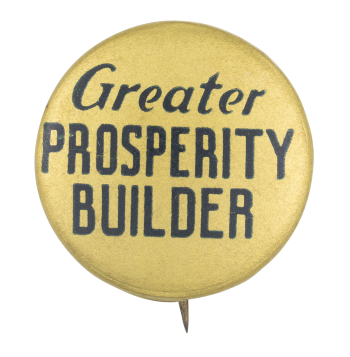| Category | |
|---|---|
| Additional Images | |
| Text on Button | Greater PROSPERITY BUILDER |
| Image Description | Black text on a gold background. |
| Back Style | |
| The Shape | |
| The Size | |
| Year / Decade Made | |
| Additional Information | In 1940, democrat Franklin Delano Roosevelt (January 30, 1882 – April 12, 1945) campaigned for an unprecedented third term as U.S. President. His Republican opponent was Wendell Lewis Wilkie (February 18, 1892 – October 8, 1944). Wilkie was not a typical republican choice: Unlike Roosevelt’s Hyde Park upbringing, and Harvard education, Wilkie was born to a modest family in a small town in Indiana. Moreover, Wilkie used to be a democrat and actually voted for Roosevelt in 1932 while supporting the New Deal. But by 1936, Wilkie had distanced himself from Roosevelt because the federal government created Tennessee Valley Authority (TVA) to compete with Commonwealth & Southern Corporation (C&S); Wilkie was the president of this private company that provided electricity to 11 states. The presidential race was boisterous and contentious. One of the focuses of Wilkie’s campaign was the third term issue and he accused Roosevelt of wanting to become a dictator. Wilkie made the argument that voting for him was a vote for democracy. His campaign was vigorous and at times aggressively personal. Campaign buttons were printed with catching phrases like No Franklin the First, No Man Is Good Three Times, Financial Debauchery Run-riot, and Prosperity Builder. Roosevelt’s campaign countered with their own buttons, like the one seen here. On November 5, 1940, Roosevelt won the presidency with 38 states and 55 percent of the popular vote. Despite the contentious campaign, Roosevelt and Wilkie developed a strong working relationship: Wilkie served as Personal Envoy of Roosevelt, meeting with world leaders like Joseph Stalin, Charles de Gaulle, Marshall Montgomery and Chang Kai-Shek. It's rumored that Roosevelt even asked Wilkie to be his vice presidential candidate for a possible fourth term in 1944. Wilkie died in October, 1944 and Roosevelt passed away less than six months later in April, 1945. |
| Sources |
Heard, S. (n.d.). When Reason Trumped Politics: The Remarkable Political Partnership of Franklin Delano Roosevelt and Wendell L. Wilkie. The Franklin Delano Roosevelt Foundation. Adams House, Harvard College. Retrieved October 19, 2024, from https://fdrfoundation.org/publications/willkie/ 1940 Wendell Wilkie Campaign Buttons. (n.d.). Franklin D. Roosevelt Presidential Library and Museum. National Archives. RetrievedOctober 19, 2024, from https://fdr.blogs.archives.gov/2012/10/24/from-the-museum-43/ Sobelman, R. (2008). Influence of the Third-Term Issue: The Roosevelt and Wilkie Presidential Campaigns of 1940. Arnold & Porter. https://www.arnoldporter.com/-/media/files/perspectives/publications/2008/04/influence-of-the-thirdterm-issue-the-roosevelt-a__/files/publication/fileattachment/influence-of-the-third-term-issue_the-roosevelt-__.pdf?rev=19fbf34e01dd474ba6d3725613b9c6bc&sc_lang=en&hash=72298A123ADCA8F3C81D27B5D3B3D751 Willkie vs Roosevelt "Prosperity Builder" Campaign Button. (n.d.) Lori Ferber Presidential Collectibles. Retrieved October 19, 2024, from https://www.loriferber.com/willkie-fdr-prosperity-builder.htmlsrsltid=AfmBOooILZwZCvBuDuBH3sXOkIUzWjwEEcTVnCDWBRpKTYfGPpUG_zAx
|
| Catalog ID | PO0828 |


